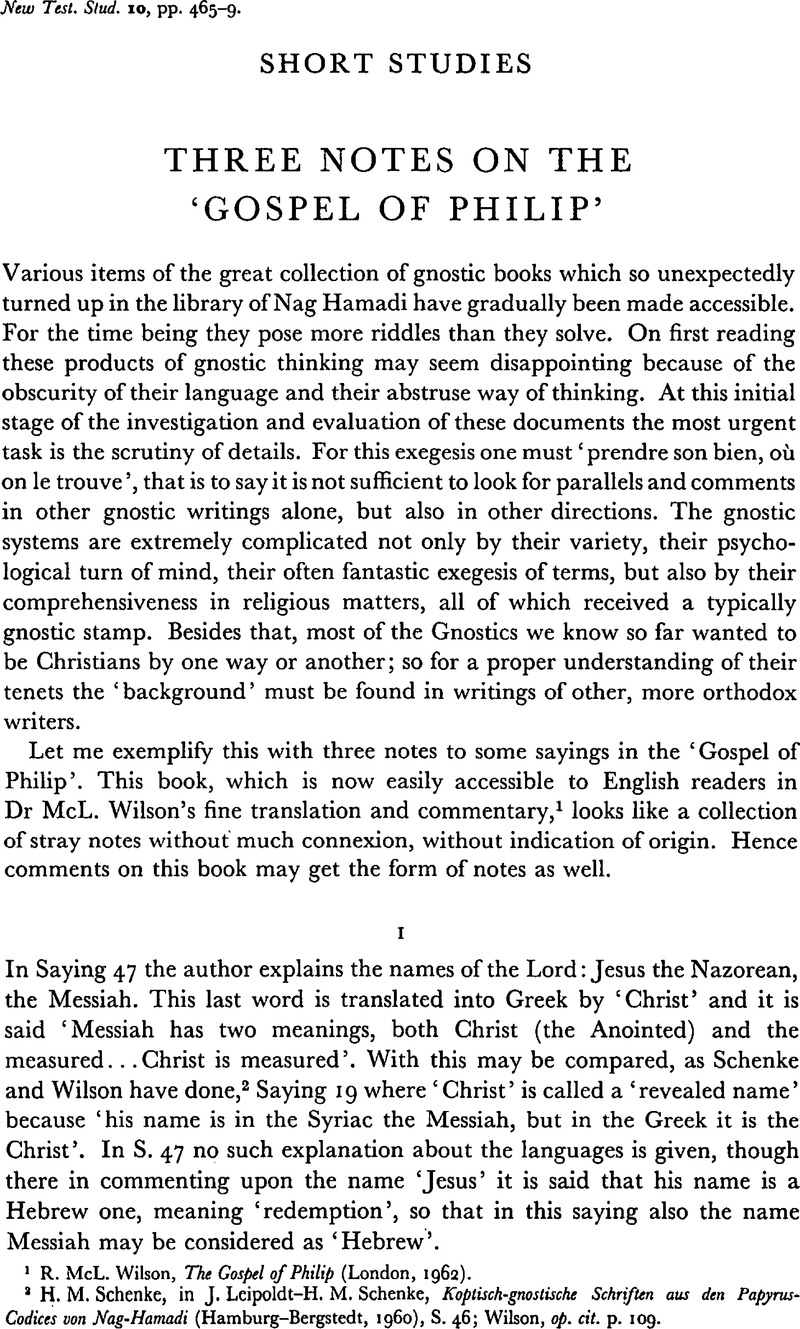Article contents
Three Notes on the ‘Gospel of Philip’
Published online by Cambridge University Press: 05 February 2009
Abstract

- Type
- Short Studies
- Information
- Copyright
- Copyright © Cambridge University Press 1964
References
page 465 note 1 Wilson, R. McL., The Gospel of Philip (London, 1962).Google Scholar
page 465 note 2 Schenke, H. M., in Leipoldt, J.–, Schenke, H. M., Koptisch-gnostische Schriften aus den Papyrus-Codices von Nag-Hamadi (Hamburg-Bergstedt, 1960), S. 46Google Scholar; Wilson, op. cit. p. 109.
page 466 note 1 That a difference between them was known, appears from the statements of Josephus, Ant. x, 2, i and xii, 1, 2.
page 466 note 2 For the proper understanding we are compelled to add the English equivalent as well.
page 466 note 3 In Onomastica Sacra, ed. de Lagarde, P. (Gottingae), p. 66Google Scholar: Messias unctus, id est Christus. This text from Jerome is the only explanation in this book.
page 466 note 4 H. M. Schenke, a. a. O. S. 46, note 2.
page 466 note 5 Levy, J., Wörterbuch über die Talmudim und Midraschim (Berlin-Wien, 1924)Google Scholar, Bd. iii, S. 270b gives two meanings: (1) salben; (2) messen; S. 272–273 s. v. Mesjiha: (1) der Gesalbte Hohepriester oder König: (2) der Messias, and then, as another item, the homonym: (1) das Salben; (2) Seil, Messschnur.—Also Dalman, G., Aramäisch-Neuhebräisches Handwörterbuch2, (Frankfurt a. Main, 1922), S. 256.Google Scholar
page 466 note 6 So, e.g. Preuschen, E., Antilegomena (Giessen, 1901), S. 65Google Scholar; Ficker, G., Sprüche und Auslegungen der Presbyter des Irenäus, inGoogle ScholarHennecke, E., Neutestamentliche Apokryphen 2, (Tübingen, 1924), S. 540–51Google Scholar; there S. 544. (other literature on the Presbyters is mentioned by Ficker, S. 540 f.).
page 466 note 7 This is, as Ficker remarked, a quotation from Sap. Sal. 2: 20; see the commentary of Goodrick, A. T. S., The Book of Wisdom (London, 1913), p. 251.Google Scholar
page 466 note 8 Ficker, a. a. O. S. 542, Nt. refers to a fragment of Melito in Syriac, where it is said: ‘the Illimitable is circumscribed’ (twice), but I doubt whether this stems from the same root, since Melito uses this expression in one of these lists of contrast, of which he is so fond; it may also be that the Greek there would be άχώρητος.
page 468 note 1 See on this point Peterson, E., Frühkirche, Judentum und Gnosis (Rom-Freiburg-Wien, 1959), S. 84–5Google Scholar and Malinine, M., Puech, H. C., Quispel, G. and Till, W., De Resurrectione (Epistula ad Rh 'ginum) (Zürich-Stuttgart, 1963), p. 20.Google Scholar
page 468 note 2 A parallel text in slightly different wording is found in Midrash Psalms 2, § 11.
page 469 note 1 So that the text could now be used as a proof for the resurrection.
page 469 note 2 Tertullianus, De Resurrectione Carnis, vii, 5.Google Scholar
page 469 note 3 Cf. Brightman, F. E., Liturgies Eastern and Western (Oxford, 1896), pp. 571–2, s.v. Bread.Google Scholar
page 470 note 1 Did. 9; Justinus Martyr, Apol. 66, 1Google Scholar; Irenaeus, Adv. Haer. iv, 18, 5Google Scholar; Origenes, Contra Cels. viii, 57 (‘the bread is called eucharistia’).Google Scholar
page 470 note 2 Smith, J. Payne, A Compendious Syriac Dictionary (Oxford, 1903), p. 462.Google Scholar
page 470 note 3 A sufficient, but not complete list of parallel texts, where the outstretching of the hands is mentioned, may be found in Windisch, H., Der Barnabasbrief (Tübingen, 1920), S. 370.Google Scholar
- 2
- Cited by




